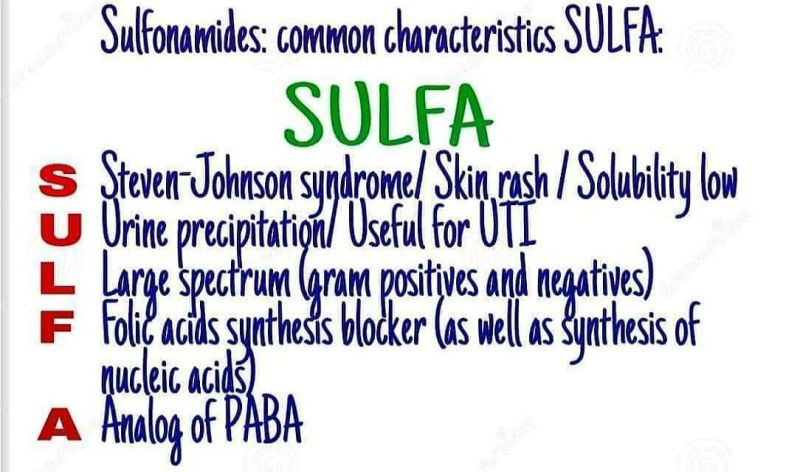Sulfonamides
Adverse reactions to sulfonamide antibiotics are relatively common (~3%), but only about 3% of these are true hypersensitivity reactions - Chris Nickson

image by: Emedicalcollege.com
HWN Suggests
'Sulfur allergy' label is misleading
Sulfonamides were the first class of antibiotics to be introduced in the 1930s. They remain important because they are effective, relatively safe and inexpensive, but adverse effects are relatively common.
Up to 8% of hospitalised patients and 1–2% of those in the community are reported to suffer adverse effects from the combination of sulfamethoxazole with trimethoprim, although only about 3% of these are thought to represent hypersensitivity...
While most hypersensitivity reactions are relatively mild, sulfonamides account for a disproportionate number of cases of life-threatening Stevens-Johnson syndrome and toxic epidermal necrolysis.
Resources
Acetazolamide and sulfonamide allergy: a not so simple story
Despite this lack of evidence, the United States Food & Drug Administration (FDA) has approved product information for many nonantibiotic sulfonamide drugs that contains warnings of possible cross-reactions.
Antimicrobials; The Sulphonamides
The sulphonamides have a long deep history from the times of Prontonsil Red to the newer products available in the markets now. They are broad spectrum and good for urinary tract infections. These indirect nucleic acid synthesis inhibitors inhibits the formation of dihydropteroic acid in the folic acid synthesis pathway.
Cross-reactivity Between Sulfonamide Antimicrobials and Non-Antimicrobials
If a patient had a true IgE-mediated anaphylatic reaction to a sulfonamide antimicrobial, it may be best to avoid other sulfa-related medications (use ethacrynic acid if a loop diuretic is needed). Otherwise, the available literature does not support cross-reactivity between sulfonamide antimicrobials and non-antimicrobials.
How Sulfa Drugs Work
Sulfa antibiotics were first used in the 1930s, and they revolutionized medicine. After a few years, bacteria started to develop resistance to the drugs, and eventually penicillin replaced them as a first-line treatment. While antibiotic resistance remains a problem for this class of antibiotics, sulfa drugs are still commonly used to treat a variety of bacterial infections.
Sulfa Drug Discombobulation
The most common manifestation of hypersensitivity is a fever or a maculopapular rash that develops 7 to 14 days after initiating the offending agent. However, there are several life-threatening manifestations of hypersensitivity to sulfa drugs.
Sulfa, sulfite, sulfate, and sulfur: True Allergy, Cross-Allergy or No Allergy
Sulfa, sulfite, sulfate, and sulfur are four terms that sound similar but have very different allergy profiles. As healthcare practitioners, it is important to understand these four terms to establish whether patients have true allergy, cross-allergy, or no allergy among drugs, herbs and foods.
Sulfonamide Allergies
As one of the earliest developed antimicrobial classes, sulfonamides remain important therapeutic options for the empiric and definitive treatment of various infectious diseases. In the general population, approximately 3–8% of patients are reported to experience a sulfonamide allergy.
Sulfonamides and trimethoprim
The first demonstration of the antibacterial effect of the chemically synthesized sulfonamides in experiments on animals was performed in 1932 by Gerhard Domagk at the University of Münster in Germany
 'Sulfur allergy' label is misleading
'Sulfur allergy' label is misleading
The term 'sulfur allergy' is misleading and dangerous and should not be used. An allergy to a sulfonamide antibiotic may imply cross-reactivity with other sulfonamide antibiotics, but does not imply cross-reactivity with non-antibiotic sulfonamides or other drugs containing sulfhydryl or sulfate groups.

Introducing Stitches!
Your Path to Meaningful Connections in the World of Health and Medicine
Connect, Collaborate, and Engage!
Coming Soon - Stitches, the innovative chat app from the creators of HWN. Join meaningful conversations on health and medical topics. Share text, images, and videos seamlessly. Connect directly within HWN's topic pages and articles.













